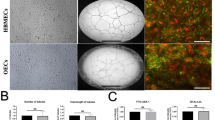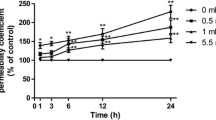Abstract
The objective of the present study was to determine the effects of glucagon-like peptide-1 (GLP-1) on barrier functions and to assess the underlying mechanism using an in vitro blood-brain barrier (BBB) model comprised of a primary culture of rat brain capillary endothelial cells (RBECs). GLP-1 increased transendothelial electrical resistance and decreased the permeability of sodium fluorescein in RBECs in a dose- and time-dependent manner. The effects on these barrier functions were significantly reduced in the presence of the GLP-1 receptor antagonist exendin-3 (9–39) and the protein kinase A (PKA) inhibitor H-89. Western blot analysis showed that GLP-1 increased the amount of occludin and claudin-5. GLP-1 analogs are approved for treatment of type 2 diabetes mellitus, and thus, we examined the effects of GLP-1 on hyperglycemia-induced BBB damage. GLP-1 inhibited the increase in production of reactive oxygen species under hyperglycemia conditions and improved the BBB integrity induced by hyperglycemia. As GLP-1 stabilized the integrity of the BBB, probably via cAMP/PKA signaling, the possibility that GLP-1 acts as a BBB-protective drug should be considered.





Similar content being viewed by others
References
Abbott NJ (2002) Astrocyte-endothelial interactions and blood–brain barrier permeability. J Anat 200:629–638
Abbott NJ (2005) Dynamics of CNS barriers: evolution, differentiation, and modulation. Cell Mol Neurobiol 25:5–23
Abbott NJ, Patabendige AA, Dolman DE, Yusof SR, Begley DJ (2010) Structure and function of the blood–brain barrier. Neurobiol Dis 37:13–25
Balteau M, Van Steenbergen A, Timmermans AD et al (2014) AMPK activation by glucagon-like peptide-1 prevents NADPH oxidase activation induced by hyperglycemia in adult cardiomyocytes. Am J Physiol Heart Circ Physiol 307:H1120–H1133
Beese M, Wyss K, Haubitz M, Kirsch T (2010) Effect of cAMP derivates on assembly and maintenance of tight junctions in human umbilical vein endothelial cells. BMC Cell Biol 11:68. doi:10.1186/1471-2121-11-68
Bell GI, Sanchez-Pescador R, Laybourn PJ, Najarian RC (1983) Exon duplication and divergence in the human preproglucagon gene. Nature 304:368–371
Boueiz A, Hassoun PM (2009) Regulation of endothelial barrier function by reactive oxygen and nitrogen species. Microvasc Res 77:26–34
Briyal S, Gulati K, Gulati A (2012) Repeated administration of exendin-4 reduces focal cerebral ischemia-induced infarction in rats. Brain Res 1427:23–34
Darsalia V, Ortsäter H, Olverling A et al (2013) The DPP-4 inhibitor linagliptin counteracts stroke in the normal and diabetic mouse brain: a comparison with glimepiride. Diabetes 62:1289–1296
Deli MA, Ábrahám CS, Kataoka Y, Niwa M (2005) Permeability studies on in vitro blood–brain barrier models: physiology, pathology, and pharmacology. Cell Mol Neurobiol 25:59–127
Dodge-Kafka KL, Soughayer J, Pare GC et al (2005) The protein kinase a anchoring protein mAKAP coordinates two integrated cAMP effector pathways. Nature 437:574–578
Donnelly D (2012) The structure and function of the glucagon-like peptide-1 receptor and its ligands. Br J Pharmacol 166:27–41
Drucker DJ, Nauck MA (2006) The incretin system: glucagon-like peptide-1 receptor agonists and dipeptidyl peptidase-4 inhibitors in type 2 diabetes. Lancet 368:1696–1705
During MJ, Cao L, Zuzga DS et al (2003) Glucagon-like peptide-1 receptor is involved in learning and neuroprotection. Nat Med 9:1173–1179
Erdogdu Ö, Eriksson L, Nyström T, Sjöholm Å, Zhang Q (2012) Exendin-4 restores glucolipotoxicity-induced gene expression in human coronary artery endothelial cells. Biochem Biophys Res Commun 419:790–795
Ergul A, Li W, Elgebaly MM, Bruno A, Fagan SC (2009) Hyperglycemia, diabetes and stroke: focus on the cerebrovasculature. Vasc Pharmacol 51:44–49
Furuse M, Tsukita S (2006) Claudins in occluding junctions of humans and flies. Trends Cell Biol 16:181–188
Ishizaki T, Chiba H, Kojima T et al (2003) Cyclic AMP induces phosphorylation of claudin-5 immunoprecipitates and expression of claudin-5 gene in blood–brain-barrier endothelial cells via protein kinase a-dependent and -independent pathways. Exp Cell Res 290:275–288
Lee CH, Yan B, Yoo KY et al (2011) Ischemia-induced changes in glucagon-like peptide-1 receptor and neuroprotective effect of its agonist, exendin-4, in experimental transient cerebral ischemia. J Neurosci Res 89:1103–1113
Li Z, Liu YH, Xue YX, Xie H, Liu LB (2011) Role of ATP synthase alpha subunit in low-dose endothelial monocyte-activating polypeptide-II-induced opening of the blood-tumor barrier. J Neurol Sci 300:52–58
Li AQ, Zhao L, Zhou TF, Zhang MQ, Qin XM (2015) Exendin-4 promotes endothelial barrier enhancement via PKA- and Epac1-dependent Rac1 activation. Am J Physiol Cell Physiol 308:C164–C175
Lovshin JA, Drucker DJ (2009) Incretin-based therapies for type 2 diabetes mellitus. Nat Rev Endocrinol 5:262–269
Maurice DH (2011) Subcellular signaling in the endothelium: cyclic nucleotides take their place. Curr Opin Pharmacol 11:656–664
McClean PL, Hölscher C (2014) Liraglutide can reverse memory impairment, synaptic loss and reduce plaque load in aged APP/PS1 mice, a model of Alzheimer’s disease. Neuropharmacology 76:57–67
McClean PL, Parthsarathy V, Faivre E, Hölscher C (2011) The diabetes drug liraglutide prevents degenerative processes in a mouse model of Alzheimer’s disease. J Neurosci 31:6587–6594
Miyoshi J, Takai Y (2005) Molecular perspective on tight-junction assembly and epithelial polarity. Adv Drug Deliv Rev 57:815–855
Nakagawa S, Deli MA, Nakao S et al (2007) Pericytes from brain microvessels strengthen the barrier integrity in primary cultures of rat brain endothelial cells. Cell Mol Neurobiol 27:687–694
Nakagawa S, Deli MA, Kawaguchi H et al (2009) A new blood–brain barrier model using primary rat brain endothelial cells, pericytes and astrocytes. Neurochem Int 54:253–263
Oeseburg H, de Boer RA, Buikema H, van der Harst P, van Gilst WH, Silljé HH (2010) Glucagon-like peptide 1 prevents reactive oxygen species-induced endothelial cell senescence through the activation of protein kinase A. Arterioscler Thromb Vasc Biol 30:1407–1414
Perriere N, Demeuse P, Garcia E et al (2005) Puromycin-based purification of rat brain capillary endothelial cell cultures. Effect on the expression of blood–brain barrier-specific properties. J Neurochem 93:279–289
Perry T, Lahiri DK, Sambamurti K et al (2003) Glucagon-like peptide-1 decreases endogenous amyloid-beta peptide (abeta) levels and protects Hippocampal neurons from death induced by abeta and iron. J Neurosci Res 72:603–612
Pun PB, Lu J, Moochhala S (2009) Involvement of ROS in BBB dysfunction. Free Radic Res 43:348–364
Sato K, Kameda M, Yasuhara T et al (2013) Neuroprotective effects of liraglutide for stroke model of rats. Int J Mol Sci 14:21513–21524
Shao B, Bayraktutan U (2013) Hyperglycaemia promotes cerebral barrier dysfunction through activation of protein kinase C-beta. Diabetes Obes Metab 15:993–999
Sjöholm A (2009) Impact of glucagon-like peptide-1 on endothelial function. Diabetes Obes Metab Suppl 3:19–25
Spindler V, Schlegel N, Waschke J (2010) Role of GTPases in control of microvascular permeability. Cardiovasc Res 87:243–253
Tureyen K, Bowen K, Liang J, Dempsey RJ, Vemuganti R (2011) Exacerbated brain damage, edema and inflammation in type-2 diabetic mice subjected to focal ischemia. J Neurochem 116:499–507
Van Itallie CM, Anderson JM (2006) Claudins and epithelial paracellular transport. Annu Rev Physiol 68:403–429
Vannucci SJ, Willing LB, Goto S et al (2001) Experimental stroke in the female diabetic, db/db, mouse. J Cereb Blood Flow Metab 21:52–60
Wohlfart P, Linz W, Hübschle T et al (2013) Cardioprotective effects of lixisenatide in rat myocardial ischemia-reperfusion injury studies. J Transl Med 11:84. doi:10.1186/1479-5876-11-84
Yan J, Zhang Z, Shi H (2012) HIF-1 is involved in high glucose-induced paracellular permeability of brain endothelial cells. Cell Mol Life Sci 69:115–128
Yang D, Nakajo Y, Iihara K, Kataoka H, Yanamoto H (2013) Alogliptin, a dipeptidylpeptidase-4 inhibitor, for patients with diabetes mellitus type 2, induces tolerance to focal cerebral ischemia in non-diabetic, normal mice. Brain Res 1517:104–113
Zlokovic BV (2008) The blood–brain barrier in health and chronic neurodegenerative disorders. Neuron 57:178–201
Acknowledgments
This work was supported in part by a Grant-in-Aid for Young Scientists (B) (24790258) from the Japan Society for the Promotion of Science (JSPS). We would like to thank Keisuke Toyoda, Gohei So for their critical reviews of the manuscript and helpful professional guidance.
Author information
Authors and Affiliations
Corresponding author
Ethics declarations
Conflict of Interest
All authors have no competing interests.
Rights and permissions
About this article
Cite this article
Fukuda, S., Nakagawa, S., Tatsumi, R. et al. Glucagon-Like Peptide-1 Strengthens the Barrier Integrity in Primary Cultures of Rat Brain Endothelial Cells Under Basal and Hyperglycemia Conditions. J Mol Neurosci 59, 211–219 (2016). https://doi.org/10.1007/s12031-015-0696-1
Received:
Accepted:
Published:
Issue Date:
DOI: https://doi.org/10.1007/s12031-015-0696-1




